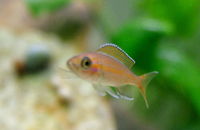Difference between revisions of "Paracyprichromis nigripinnis"
From The Aquarium Wiki
| (4 intermediate revisions by 3 users not shown) | |||
| Line 1: | Line 1: | ||
{{Fish Data | {{Fish Data | ||
| − | |stub= | + | |stub=No |
|name=Black Fin Cichlid | |name=Black Fin Cichlid | ||
|species=Paracyprichromis nigripinnis | |species=Paracyprichromis nigripinnis | ||
| Line 34: | Line 34: | ||
|max_water_hardness=16 | |max_water_hardness=16 | ||
}} | }} | ||
| − | + | ||
| + | == Origin == | ||
| + | :Endemic to Lake Tanganyika, in Africa. | ||
| + | |||
| + | |||
| + | == Sexing == | ||
| + | :Difficult when young, mature males are more intensely coloured. | ||
| + | |||
| + | == Breeding == | ||
| + | :Mouth breeder, a male will fertilize the eggs of the female near a rock. | ||
| + | |||
| + | == Tank compatibility == | ||
| + | :Docile cichlids that do well in most Tanganyikan communities, they inhabit the upper layer of the aquarium, so bottom- and rock inhabitants with low or mediocre aggression are a good choice as tankmates. | ||
| + | |||
| + | |||
| + | == Diet == | ||
| + | :Prefers a omnivorous diet, including live food, small fish, [[mysis shrimp]], large aquatic insects and crustaceans. Dry foods should be accepted when the fish settle into their tank, especially in captive fish. | ||
| + | |||
| + | |||
| + | == Feeding regime == | ||
| + | :Feed once or twice a day, as with most fish. | ||
| + | |||
| + | |||
| + | == Environment specifics == | ||
| + | :Like most other Tanganyikan cichlids, this fish does not deliberately damage plants, so plants can be kept. Most variants grow to about 3-4 inches and live in the upper layer of the aquarium. They need rockwork to breed, so they should be provided with (vertical) rock piles. Can be kept in a 40 gallon minimum aquarium. Like most Tanganyikan cichlids, do not take excess nitrates very well, so tanks should have two 25% water changes weekly: they also do not like changing water conditions, so the new water should be close in parameters to the old water. | ||
| + | |||
| + | |||
| + | == Behaviour == | ||
| + | :Does not school, but is best kept in small groups. Is very active, but not aggressive. It will not claim any rocks or sand territory. | ||
| + | |||
| + | |||
| + | == Identification == | ||
| + | :Rusty colour with blue lines. | ||
| + | |||
| + | |||
{{Categories | {{Categories | ||
|Category=Fish, Fish (Freshwater), Cichlids, Cichlids (African), Cichlids (Lake Tanganyika) | |Category=Fish, Fish (Freshwater), Cichlids, Cichlids (African), Cichlids (Lake Tanganyika) | ||
| Line 42: | Line 76: | ||
Image:Paracyprichromis_Nigripinnis-2.JPG|Group | Image:Paracyprichromis_Nigripinnis-2.JPG|Group | ||
</gallery> | </gallery> | ||
| + | |||
| + | == Videos == | ||
| + | {| | ||
| + | |- | ||
| + | | | ||
| + | |Paracyprichromis nigripinnis blue neon | ||
| + | |- | ||
| + | | | ||
| + | |<youtube>RLB0TptmxRM</youtube> | ||
| + | |} | ||
| + | |||
| + | {| | ||
| + | |- | ||
| + | | | ||
| + | |Care: | ||
| + | |- | ||
| + | | | ||
| + | |<youtube>AyIgfYr9GaY</youtube> | ||
| + | |} | ||
== External links == | == External links == | ||
*{{FishBase |id=8782}} | *{{FishBase |id=8782}} | ||
Latest revision as of 18:36, 21 December 2023
Black Fin Cichlid
Paracyprichromis nigripinnis
208 Litres (55 US G.)
10-11 cm (3.9-4.3")
Freshwater
7.5 - 8.0
23 -25 °C (73.4-77°F)
6-16 °d
1:1 M:F
5-8 years
Family
Cichlidae
Contents
Origin[edit]
- Endemic to Lake Tanganyika, in Africa.
Sexing[edit]
- Difficult when young, mature males are more intensely coloured.
Breeding[edit]
- Mouth breeder, a male will fertilize the eggs of the female near a rock.
Tank compatibility[edit]
- Docile cichlids that do well in most Tanganyikan communities, they inhabit the upper layer of the aquarium, so bottom- and rock inhabitants with low or mediocre aggression are a good choice as tankmates.
Diet[edit]
- Prefers a omnivorous diet, including live food, small fish, mysis shrimp, large aquatic insects and crustaceans. Dry foods should be accepted when the fish settle into their tank, especially in captive fish.
Feeding regime[edit]
- Feed once or twice a day, as with most fish.
Environment specifics[edit]
- Like most other Tanganyikan cichlids, this fish does not deliberately damage plants, so plants can be kept. Most variants grow to about 3-4 inches and live in the upper layer of the aquarium. They need rockwork to breed, so they should be provided with (vertical) rock piles. Can be kept in a 40 gallon minimum aquarium. Like most Tanganyikan cichlids, do not take excess nitrates very well, so tanks should have two 25% water changes weekly: they also do not like changing water conditions, so the new water should be close in parameters to the old water.
Behaviour[edit]
- Does not school, but is best kept in small groups. Is very active, but not aggressive. It will not claim any rocks or sand territory.
Identification[edit]
- Rusty colour with blue lines.
Pictures[edit]
Videos[edit]
| Paracyprichromis nigripinnis blue neon | |
| Care: | |
External links[edit]
- Fishbase (Mirrors:
 )
)

